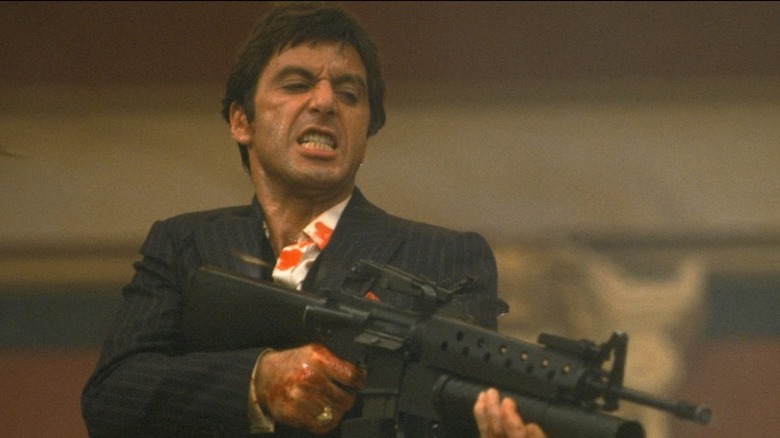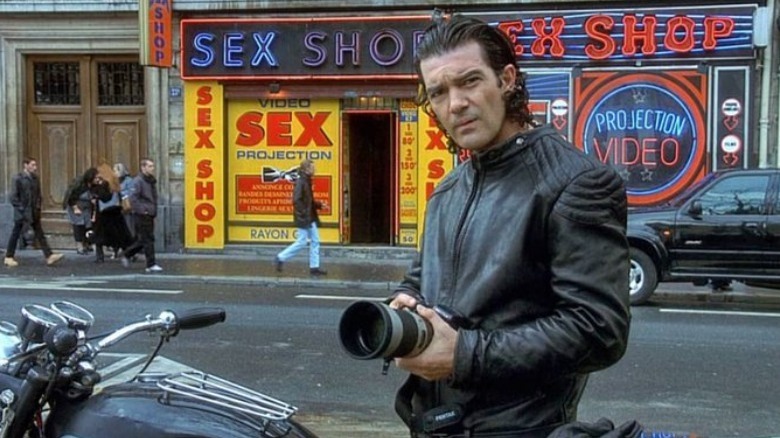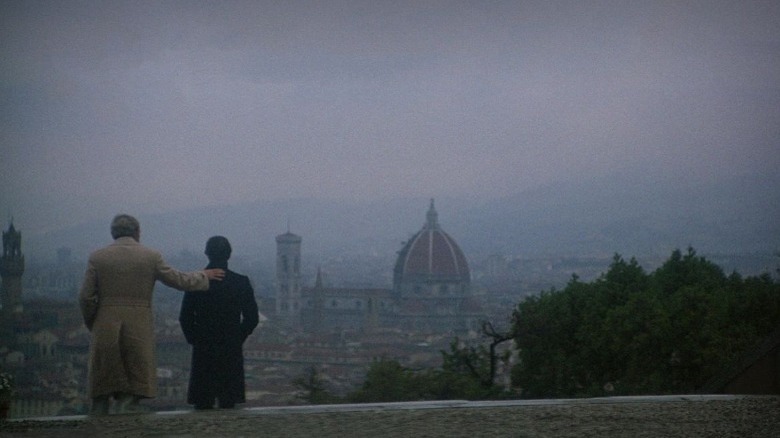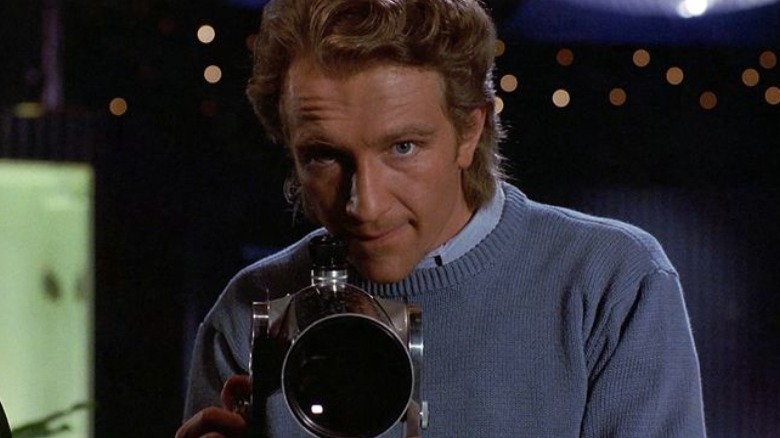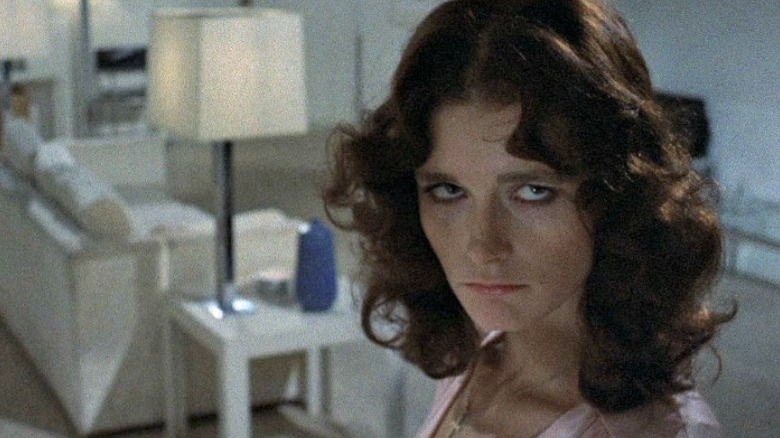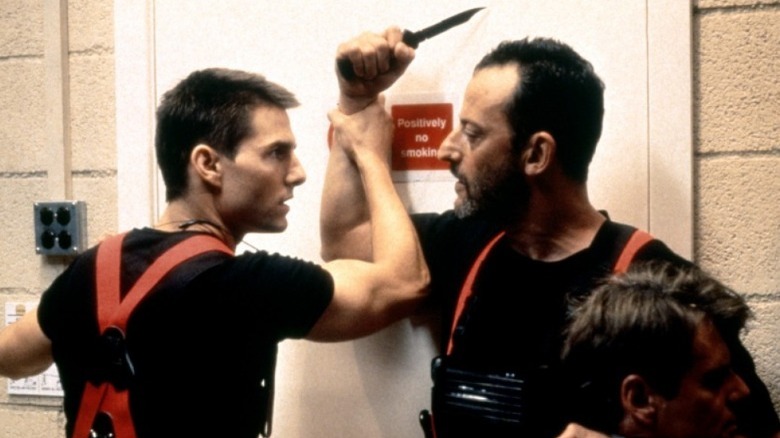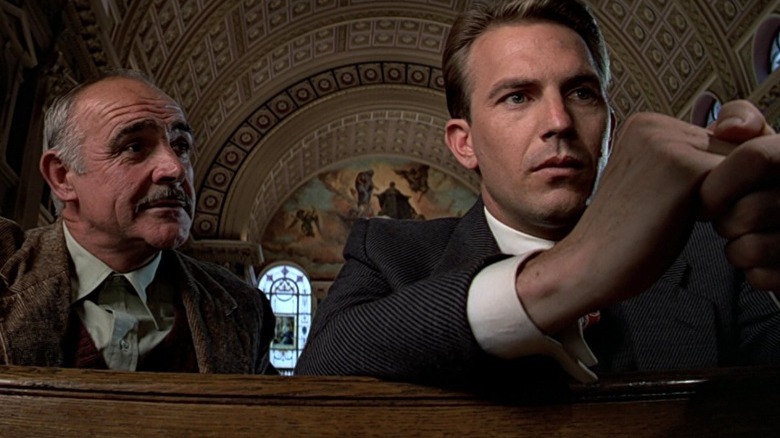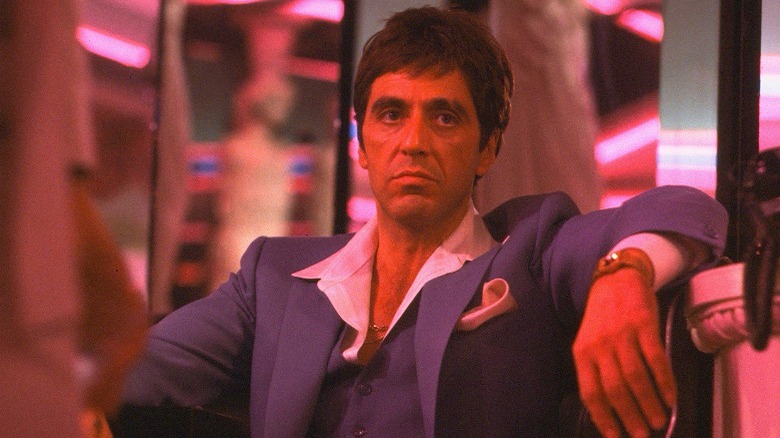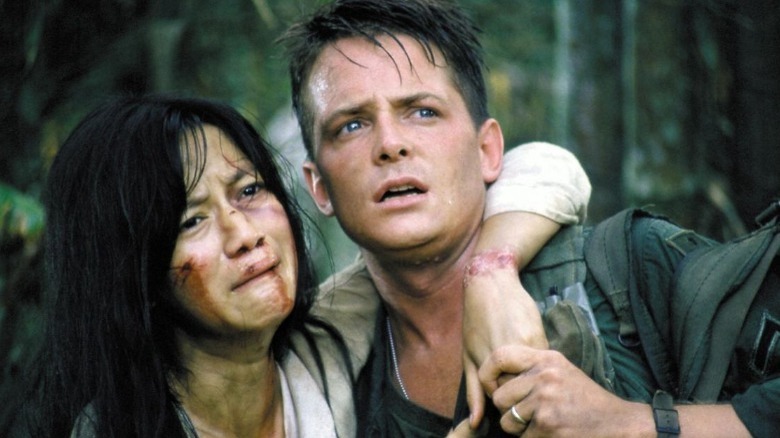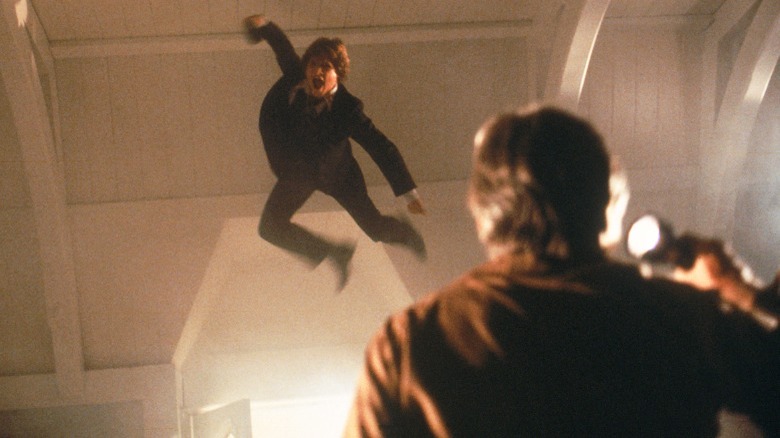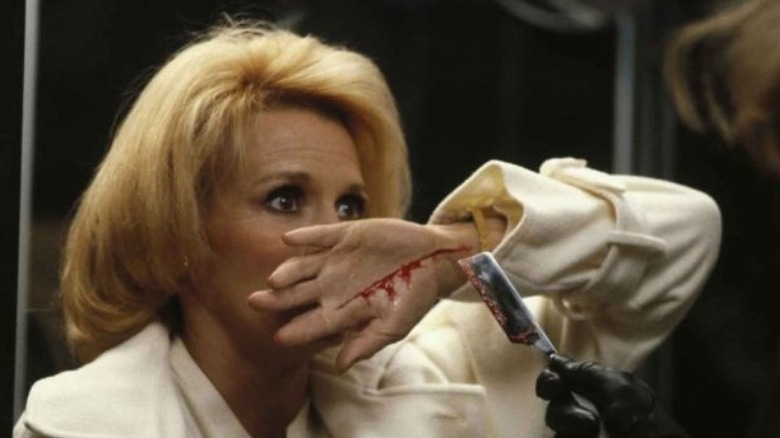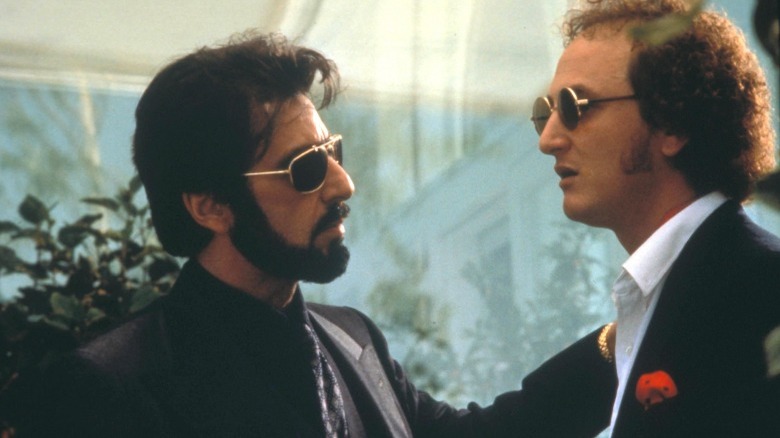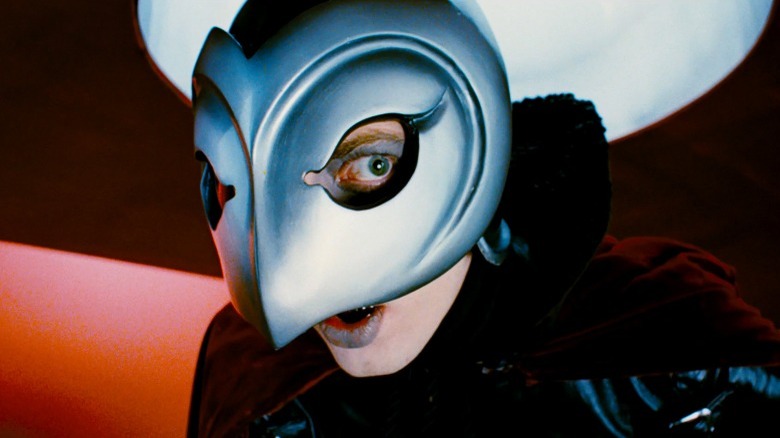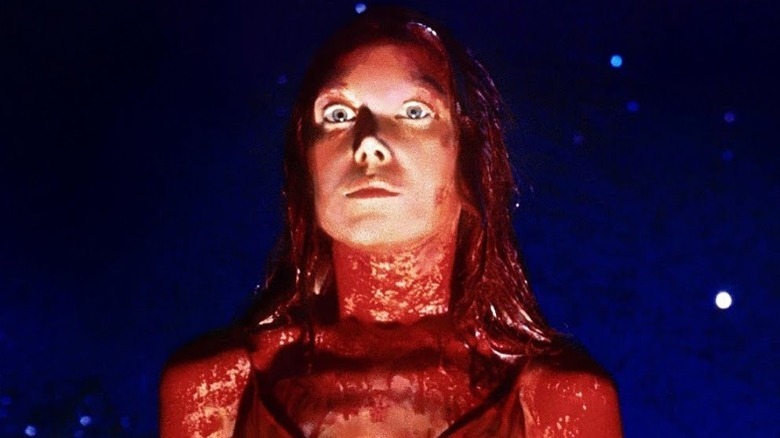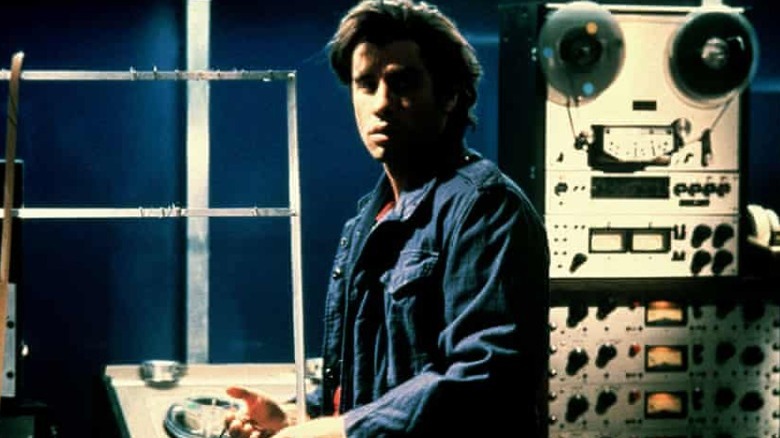The 14 Best Brian De Palma Movies Ranked
Of all the prominent Movie Brat directors (Steven Spielberg, Martin Scorsese, Francis Ford Coppola, George Lucas, et al), Brian De Palma is arguably the most polarizing. Lauded by critics like Pauline Kael, he has also been accused of misogyny and plagiarism, while in terms of box office numbers he has undeniably had more misses than hits.
While his contemporaries each had multiple blockbuster successes and/or critically acclaimed masterpieces to their names, De Palma never achieved that level of prestige with his films, instead content to make "artful trash of the highest order," as Dazed's Nick Chen put it. He has had several successes, but nothing that broke through the public consciousness in the same way as "The Godfather," "Jaws," or "Star Wars."
What he does have is a distinct style and an eclectic filmography which is often more than the sum of its parts. You can find beautifully constructed virtuoso set pieces in all of his films, even the ones that ultimately don't work. Noah Baumbach and Jake Paltrow's edifying 2016 documentary "De Palma" does an illuminating job covering every entry in his filmography, success or failure. He's one of the most cine-literate directors Hollywood has ever seen, and the 14 films below are a testament to this.
14. Femme Fatale (2002)
Despite its bad reputation, "Femme Fatale" is worth another look. Rebecca Romijn plays an enigmatic thief who double-crosses her criminal associates to escape to America, only for her new life to be upended by a charismatic paparazzo (Antonio Banderas). All the characters in the film are more broad archetypes than realistic, and the minimal script allows Brian De Palma to use almost exclusively visual storytelling to convey information.
From the very start, De Palma pays homage to film noir as Romijn watches "Double Indemnity" in the film's prologue, and the playful persona Banderas adopts to get into her room recalls Humphrey Bogart in "The Big Sleep." That seedy, amoral feel is kept throughout the film. It's also reminiscent of the Giallo genre, and the fever-dream quality that infuses the entire film is very Dario Argento (there's a shot replicated wholesale here from "Tenebrae"). "Femme Fatale" might be a little unfocused compared to the pinpoint accuracy of his earlier work, but it's still unmistakably De Palma, and certainly his best film post-2000 (we don't talk about "Domino").
13. Obsession (1976)
From early in his career, Brian De Palma made a name for himself as a director who wasn't afraid to pay explicit homage to his influences, especially Alfred Hitchcock. "Obsession" is a remake of "Vertigo" in all but name (with shades of "Don't Look Now"). Cliff Robertson plays a businessman whose wife and daughter are killed in a kidnapping gone wrong. When he visits Italy 20 years later, he meets the doppelganger of his wife (Geneviève Bujold) and slowly but surely begins a relationship with her. Paul Schrader's melodramatic screenplay and Bernard Herrmann's operatic score compliment De Palma's style perfectly and come together to create a sumptuous homage to Hitchcock and the classic era of Hollywood. It's a much classier film than you might expect from De Palma, but as such, it also lacks the personal feel of his very best work. It's a conventional story elevated by the way it's told, with a final shot that is just devastating.
"Obsession" features some stunning cinematography, and would be even higher on this list if it didn't feel quite so much a retread of Hitchcock. Other homages from De Palma have his own indelible fingerprints on them, less so here. His work on this movie sometimes feels like a director for hire, and Cliff Robertson's cold performance doesn't generate much sympathy. Thank God John Lithgow is on hand as his Southern partner, bringing some much-needed levity to a film that's often pretty dour.
12. Body Double (1984)
This is easily De Palma's sleaziest, most sexualized film, and that's saying a lot for him! Jake Scully (Craig Wasson) is a down on his luck actor who becomes infatuated with the beautiful exhibitionist lady who lives opposite the apartment he's looking after for a friend. While watching one of her nightly stripteases, he witnesses her being brutally murdered and sets out to find her killer. It's a gaudy, sensational film (the woman is murdered with an incredibly phallic drill), and the sequence where Scully finds himself in a music video for Frankie Goes To Hollywood's "Relax" is one of the campiest, most self-aware sequences De Palma ever constructed.
You get the sense that he is having fun with filmmaking techniques, most evident in the climactic showdown that is more artfully directed than it has any need to be. It feels positively avant-garde —especially considering the lurid plot up to that point — as the open grave gets deeper and deeper, and Scully's panic attack takes hold before he retreats fully into a waking nightmare. A pulpy thriller that pays homage to "Rear Window," "Vertigo," and "Peeping Tom," it also gave Melanie Griffith a legitimate star-making turn as porn star Holly Body. As in "Something Wild," she's both disarmingly sexual and incredibly sweet ... you just wish she was in the film for longer.
11. Sisters (1972)
After a number of experimental, largely comic films, "Sisters" feels like the first proper Brian De Palma movie, albeit maybe a first draft. Margot Kidder and Jennifer Salt shine in opposing roles, as a troubled model and a tenacious investigative journalist respectively. When Salt witnesses a vicious murder from her kitchen window, she is determined to uncover what happened, but by the time the police get to the murder scene the body has vanished, and the prime suspect (Kidder) seems to genuinely not know what has happened, even as she covers up for her unstable twin sister.
Hitchcockian in the best way until the point where Salt's investigations lead her to an insane asylum, where De Palma's experimental roots shine through as it switches to black and white. It features all the trademarks we now associate with De Palma: voyeurism, shocking violence, bravura camera techniques (split-screen in a fantastic show stopping sequence), strong female characters, a melodramatic score (courtesy of Alfred Hitchcock alum Bernard Herrmann), and a heavy dose of irony. The ending is a little unsatisfying, even if on paper it sounds effective ("It was all a ridiculous mistake"), but as a blueprint for his career going forward "Sisters" isn't a bad start.
10. Mission: Impossible (1996)
It's easy now to view the first "Mission: Impossible" film as a bit quaint, especially when compared to the big-budget, special effects-laden spy movies that followed. While the subsequent films in the series would largely follow a fairly conventional spy formula, Brian De Palma combines the spy aesthetic of the "Mission: Impossible" TV show with a Hitchcockian "wrong man" plot that sees Ethan Hunt (Tom Cruise) framed as a traitor and desperately trying to prove his innocence. It's essentially a suspense thriller, with Hunt using detective work just as much as the hi-tech gadgets to piece together the twisty plot. De Palma brings his unique sensibility to the production and compliments the espionage aspects of the film perfectly, drawing focus toward little clues that pay off later.
Cruise was a star already at this point, but he still feels like a human being here rather than a superhuman, which makes the breathtaking stunts all the more impactful. "Mission: Impossible" remains the most singular film in the entire series. It's dark, moody, cynical, and while the series is generally one of the few franchises to have stayed fairly consistent throughout, the first one is still the most auteur-driven.
9. The Untouchables (1987)
When you strip "The Untouchables" down to its core, it's a very strange film. Factually inaccurate, it's best viewed today as a film version of the gung-ho 1959 TV series, with everything that implies. Kevin Costner's painfully earnest performance as head G-man Eliot Ness, Robert De Niro as a larger-than-life Al Capone, the overly dramatic score from Ennio Morricone, and the way it plays fast and loose with any semblance of reality in favor of a more thrilling story.
This might sound like a criticism, but it's such a lavishly made, vivid film that it doesn't take long for these concerns to melt away. One of the most iconic gangster movies of all time, and De Palma's most fun outing in terms of sheer spectacle. You get the sense that he's less interested in the story as much as the showstopping set pieces, which happen to be several of the most impressive cinematic sequences of his career. Added to that is the dense, memorable dialogue by David Mamet, as well as excellent performances across the board. Sean Connery won the best supporting actor Oscar, but Andy Garcia and Charles Martin Smith are equally great, and Billy Drago makes a truly detestable villain as Capone's chief hitman.
8. Scarface (1983)
Loud, excessive, vibrant, and incredibly violent, De Palma's incendiary remake of Howard Hawks' classic gangster movie is a cult classic, and still largely holds up despite the lack of any sympathetic characters. As the force of nature that is Tony Montana, Al Pacino gives a performance that couldn't be further from the implacable Michael Corleone. De Palma's choice to steer away from moody neo-noir and embrace bright colors fits perfectly with the film's garish tone, giving it a distinct look. Oliver Stone's script introduces several indelible moments into the film lexicon, including the chainsaw scene and the immortal line "say hello to my little friend!"
As a piece of cinema, it's brilliantly made, with several stand-out set pieces and a supporting cast all struggling manfully to compete with the scenery-chewing turn from Pacino. Of all of them, Robert Loggia fares best as the implausibly genial mob boss, but it's Pacino's film. Montana is never likable, but his forceful personality and the sheer dynamism of Pacino's performance make him eminently watchable, and what the film conveys through his meteoric rise and inevitable fall is the way everyone who sticks with Tony ends up dead. He's a volatile character who poisons everyone around him, eventually finding himself alone save for the biggest pile of cocaine you've ever seen. Smart and tenacious enough to reach the top, but too unpredictable to stay there.
7. Casualties of War (1989)
An uncharacteristically earnest, somber piece from De Palma, and one that is unfairly neglected despite Quentin Tarantino dubbing it "the greatest war movie." "Casualties of War" both suffers and benefits from its relatively small scale story. Rather than the epic scale you might associate with films like "Apocalypse Now," De Palma focuses on one single atrocity depicted in harrowing detail: The rape and murder of an innocent Vietnamese girl by a group of disillusioned U.S. soldiers. The hero of the story is the one member of the platoon who speaks out, played by Michael J. Fox in the most impressive performance of his career. It's a film that details the evils committed by normal people without ever shying away from it.
De Palma does an incredible job giving all his characters depth. Sean Penn's sergeant is a monster for sure, but he's a monster created by the war itself. De Palma never excuses him but shows him to be a lot more nuanced than you might expect, and Penn creates a character that is callous, brutal, and all-too-human. Meanwhile, Thuy Thu Lee's performance as the Vietnamese girl is even better, incredibly painful and heartbreaking in its rawness. De Palma later returned to similar ground with "Redacted," but "Casualties of War" remains his most emotional film and deserves more recognition.
6. The Fury (1978)
An unusual film that very much played off of the success of "Carrie," taking the telepathic abilities of Carrie White and placing them in an espionage/conspiracy thriller setting. Kirk Douglas plays the vengeful Peter Sandza, determined to rescue his telekinetically gifted son Robin (Andrew Stevens) from the clutches of his former best friend (John Cassavetes) while constantly evading government agents. Cassavetes himself is deliciously evil as the shady government agent who kidnaps and exploits "gifted" teenagers and keeps them in his institute (think a sinister X-Men). Robin becomes increasingly Nietzschean and unstable, so high school student Gillian (Amy Irving) is taken to the institute where she teams up with Peter to rescue him.
It's a silly movie for sure, but Kirk Douglas plays it admirably straight, keeping everything grounded in reality and bringing a level of prestige to a very schlocky premise. One of De Palma's most underrated entries, it gave him an opportunity to use certain effects and ideas he couldn't utilize in "Carrie." "The Fury" never caught the imagination of audiences in the same way as De Palma's other films, but it's due for a reappraisal as it contains some excellent moments, not least being the explosive ending.
5. Dressed To Kill (1980)
One of the director's most divisive films, "Dressed To Kill" has aged better and worse than any other film on this list. The filmmaking on display is measured and mature, and De Palma is to be commended for approaching the sensitive subject matter of gender dysphoria. It's just unfortunate that he handles it with the subtlety of a sledgehammer, using that character as a plot device rather than exploring the subject in any real depth. What the film does successfully is pay loving homage to both the Giallo genre and Alfred Hitchcock, particularly "Psycho" in the central murder (instead of a shower it's set in an elevator, another location where you are uniquely vulnerable).
The comparisons with "Psycho" don't end there, with the string orchestral score, the shower scene fake-out in the film's introduction, and the death of the lead character only 30-minutes into the runtime after a lengthy bit of misdirection. Angie Dickinson, Nancy Allen, Keith Gordon, and Michael Caine all give nuanced, sensitive performances. Allen and Gordon have wholesome chemistry together, and Caine in particular is brilliant. The Brit gives an unusually guarded, reserved turn as Dickinson's straitlaced psychiatrist, but it's a performance choice that makes perfect sense by the film's end. Today it stands out as one of his most visually impressive and purely cinematic films (the gallery scene alone is a masterclass in non-verbal storytelling), and one that is incredibly rewarding on a rewatch.
4. Carlito's Way (1993)
From the start of "Carlito's Way" we know that Al Pacino's titular gangster is not getting out of this alive. Introduced in his dying moments recounting the events leading to his fatal shooting, it all contributes to the sense of doom that hangs over the entire story. Throughout the film he tries to get out of his criminal lifestyle, but as with "The Godfather," his criminal associates keep pulling him back in. Pacino is incredible, conveying so much with just a look from his intense eyes and incredibly expressive movements. He gives a more measured, nuanced performance than in "Scarface." Even better is Sean Penn, almost unrecognizable as the nebbishy sleazy lawyer who gets Carlito out of jail in the film's opening moments, but who quickly reveals himself to be more ambitious than he appears.
Even though De Palma would subsequently take on bigger budget films, "Carlito's Way" is still his most technically impressive achievement. The final chase, the various assassination attempts, and the scene in the pool hall are all aces. The fluidity of his Steadicam throughout and the seemingly impossible camera angles are insanely complex and well constructed. De Palma once said he could never make a better film than this, and considering the films that followed we tend to agree.
3. Phantom of the Paradise (1974)
A rock opera may seem like an odd choice for De Palma, but from the moment Rod Serling's voice reverberates in the prologue of this Faustian cult musical, you know you're in for a treat. Paul Williams wrote all the songs and plays the demonic musical Svengali Swan, who steals the cantata written by Winslow Leach (William Finley) which indirectly contributes to Leach becoming the vengeful Phantom. The cast all give colorful, over-the-top performances, with Finley making Leach both obsessive and sympathetic. Jessica Harper is great as the soulful Phoenix, and Gerrit Graham is a scene-stealer as the Frankenstein-inspired Beef.
The way Williams re-purposes the same song to fit within the different styles of music is ingenious. He depicts the literal soul-destroying process of having your work stripped of its uniqueness only to be repackaged and commercialized into something bland and inoffensive. De Palma was supposedly inspired to make the film when he heard a Muzak version of a Beatles song in a lift. If anything, Williams was too successful, making every song insanely catchy, with "Old Souls," "Life At Last," and especially "The Hell Of It" well worth looking up. In a neat touch, Williams even gets to sing the film's main theme when Swan gives the Phantom a voice box that replicates Williams' own singing voice. A favorite of director Edgar Wright, who emulated the Phantom's billowing cloak in "Hot Fuzz," this is finally going up in audience estimation but is still criminally underseen.
2. Carrie (1976)
"Carrie" is just about a perfect example of how to adapt a book successfully. It's very definitely a Brian De Palma film while remaining faithful to the book at all times, in spirit if not in every respect. De Palma uses his entire toolkit of filmmaking techniques — split screens, creative editing, long tracking shots — but the camera trickery is used sparingly and always in service to the story. The genius of the film lies in utilizing visual style to tell the story without ever feeling showy or getting in the way of the narrative.
The thing is, this shouldn't work as an adaptation of Stephen King's novel. The waif-like Sissy Spacek is the polar opposite of the characterization of Carrie of the book, and yet it works perfectly due to her painfully innocent performance. It's a masterstroke of casting as it puts the audience firmly on her side, which is essential in making the fateful prom night as devastating as possible. While we might take a macabre satisfaction in the fates of the school bullies, Spacek's abrupt shift in performance style is genuinely terrifying. "Carrie" still feels fresh and vibrant today, and is one of the best adaptations of a King novel, with the author himself saying he liked it "quite a bit." That's high praise from someone who is notoriously protective of his work. Oh, and that last scene is unsurpassed as a final jump scare.
1. Blow Out (1981)
Referred to by J. Hoberman as "the last '60s movie," "Blow Out" is De Palma's loving tribute to conspiracy thrillers "The Conversation" and "Blow-Up." He delivered a film that is both a breezy thriller and something a lot darker, with a bleak gut-punch of an ending that still resonates today. Panned on its release, today it can be appreciated for the masterpiece it is. Jack (John Travolta) is a jaded sound man whose microphone picks up the audio of an assassination, a gunshot that sends a car containing a presidential candidate crashing into a river. After diving in and rescuing the call girl passenger Sally (Nancy Allen), he digs deeper and finds himself in the midst of a government conspiracy, monitored at all times by sinister assassin Burke (a terrifying John Lithgow).
This remains the ultimate De Palma movie, the perfect microcosm of his style and technique. The compositions alone are incredible, with Split-Diopter shots used beautifully as well as the camerawork and sound design being on point throughout. Despite the bleak tone it never feels like a slog, chiefly due to the excellent performances of Travolta, Allen, and Lithgow, but also because of the clear affection De Palma has for the technology of the time. The painstaking sequence where Jack splices together the audio and images of the crash is a hypnotic delight.
